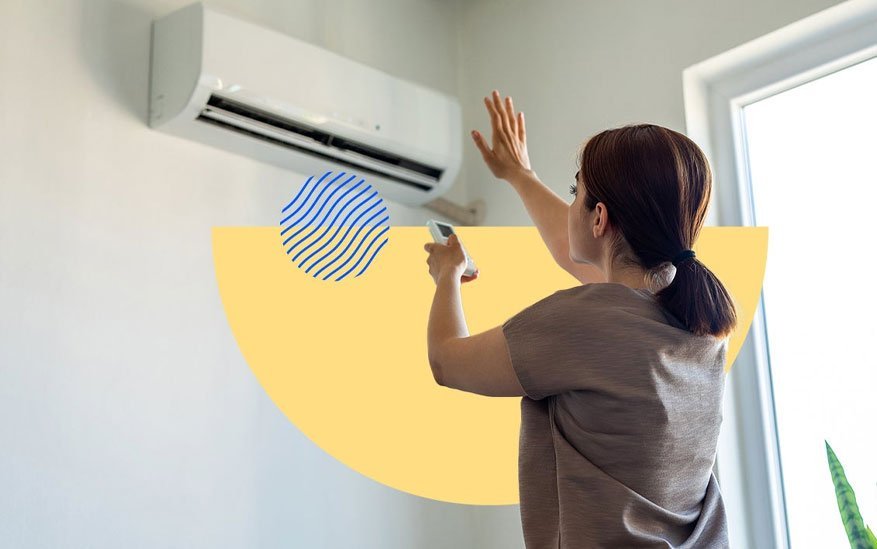Setting the right temperature on your air conditioner is important for staying comfortable during the hot summer months. The temperature you set ultimately impacts your energy bills, health, and overall well-being when spending time indoors. Striking the optimal balance between refreshing coolness and energy efficiency requires understanding your comfort needs, the capabilities of your cooling system, and best practices for temperature management.
The importance of setting the right temperature for comfort and energy efficiency
The temperature setting on your thermostat directly controls how often your air conditioning cycles on to cool your home. Setting your thermostat lower may seem like the best way to feel cooler, but this comes at a cost. Excessively cold indoor temperatures lead to higher electricity bills and unnecessary greenhouse gas emissions from increased energy consumption. Setting an appropriate temperature keeps your home comfortably cool while maximizing efficiency.
The impact of air conditioner temperature on health and well-being
Indoor temperatures also affect your health, sleep quality, productivity, and even mood. Too warm of an indoor environment can cause restlessness, dehydration, and impaired concentration and decision making. Overly cold temperatures prompt your body to work harder to maintain its natural temperature, and this can cause fatigue and seasonal depressive symptoms. Finding the right balance has real impacts on your well-being.
Overview of the factors to consider when setting the air conditioner temperature
Your ideal temperature setting depends on your physiology, age, humidity levels, the size of your home, and more. The proper way to calibrate room temperature also shifts based on whether you are at home or away. We will explore all the dynamics at play in detail so that you can make an informed decision for your air conditioning needs.
Understanding the Recommended Temperature Range
The recommended temperature range for indoor comfort during summer
The Environmental Protection Agency (EPA) suggests setting your thermostat to 78°F (25°C) to maximize energy savings. Meanwhile, the Department of Energy sets a broader baseline of 78°F on the high end and 68°F (20°C) on the low end. In general, ideal comfort for most people falls between these ranges at around 72-76°F (22-24°C). Health experts also endorse these recommendations as safest for avoiding health risks from temperature extremes.
Factors that influence the ideal temperature setting for different individuals and households
However, your personal temperature preference may vary significantly depending on:
- Age and underlying medical conditions
- Metabolic rates and fitness levels
- Humidity and access to airflow
- Size and efficiency of living spaces
For example, the elderly and very young require warmer settings around 74-78°F to maintain body heat. Fit adults tend to feel most comfortable around 70°F. Those living in humid climates may select cooler temperatures to compensate for moisture in the air. Smaller homes require less extreme cooling power than large houses. Many subtleties impact perceived comfort.
The role of humidity in determining the optimal air conditioner temperature
Outdoor humidity is a major determinant of the ideal indoor temperature. Humid conditions prevent sweat from evaporating off skin as quickly, sabotaging the body’s natural cooling abilities. This amplification of heat translates to needing a lower thermostat setting with higher humidity. On more arid days, you can nudge the temperature slightly warmer without discomfort. Tuning into local humidity guides appropriate adjustments.
Energy Efficiency and Cost Considerations
The relationship between temperature settings and energy consumption
Extreme cold temperatures demand the air conditioner constantly run its cooling mechanism. Even nudging the temperature just a few degrees lower significantly increases energy use:
- 78°F: Maximum efficiency for energy savings
- 76°F: Uses about 6% more electricity than 78°F
- 74°F: Uses about 10% more electricity than 78°F
- 72°F: Uses 18% more electricity than 78°F
As this demonstrates, seemingly innocuous temperature adjustments translate to non-trivial impacts on energy consumption. This quickly accelerates electricity expenses on your utility bills.
Tips for optimizing air conditioner temperature to save on energy costs
Balancing comfort and cost savings depends on smart management of your thermostat settings. Useful tips include:
- Set the temperature as high as comfortably possible
- Only lower the temperature minimally on exceptionally hot and humid days
- Adjust vents to target rooms you use most frequently
- Set higher temperatures when leaving the house for over 4 hours
Programming your thermostat with these customizations generates substantial long-term energy savings.
The potential environmental impact of air conditioner temperature settings
Rampant air conditioner use strains energy grids and indirectly produces massive carbon dioxide emissions contributing to climate change. In the United States alone, cooling accounts for over 6% of all home electricity usage annually. Adopting more eco-conscious temperature protocols helps mitigate your environmental footprint related to indoor climate control. Just a few degrees adjustment makes a meaningful difference.
Health and Comfort Implications
The effects of extreme temperatures on health and well-being
Excessively high and low temperature exposure presents several health risks:
- Heat stress from warmer settings prompts fatigue, cramps, and heat stroke
- Cooler air can constrict blood vessels and aggravate allergies and asthma
- Prolonged exposure to extremes suppresses immune function
Fluctuating between temperature extremes also negatively impacts sleep, mood, focus, and coordination. Optimizing the comfort level of your home attenuates these issues.
Strategies for maintaining a comfortable indoor environment without overcooling
Here are some tactics for enhancing comfort without maximizing your AC:
- Use ceiling fans to feel up to 4°F cooler through airflow
- Open windows in the evenings when outdoor air is cooler
- Cook, run heat-producing appliances, and shower at night
- Keep all windows and doors sealed while running the AC
- Install blackout curtains to prevent heat intrusion
The importance of proper air conditioner maintenance for optimal performance
Dirty air filters, refrigerant leaks, duct issues, and accumulated debris degrade cooling capabilities over time. Performing routine maintenance ensures your AC consistently regulates temperatures according to the set thermostat settings. Otherwise, you may inadvertently compensate for a malfunctioning unit by over-adjusting the temperature.
Smart Thermostats and Temperature Management
The benefits of using smart thermostats to regulate air conditioner temperature
Smart or programmable thermostats optimize efficiency by automatically adjusting settings to accommodate your living patterns. Benefits include:
- Create customized heating and cooling schedules matching your daily and weekly routines
- Automatically conserve energy when you are sleeping or away from home
- Integrate with smartphone apps for remote temperature adjustments
- Use sensors and predictive algorithms to intelligently cool just the necessary spaces
How smart thermostats can adapt to individual preferences and schedules
Connected thermostats learn from manual temperature changes and occupancy patterns over their first weeks of use. From this data, they tailor heating and cooling capabilities to your lifestyle for maximized comfort. These devices continue adapting to seasonal shifts or changes in your Home dynamics.
Tips for maximizing the efficiency of smart thermostat settings
Follow these best practices for leveraging smart thermostats:
- Input your typical schedules and temperature preferences during initial setup
- Manually adjust the temperature during the first weeks to train the device on your comfort needs
- Use geofencing features to automatically scale back when leaving your home
- Enable eco-mode options to further drive energy savings
- Check that humidity settings properly calibrate cooling rates
Best Practices for Setting the Air Conditioner Temperature
General guidelines for setting the air conditioner temperature
Use these evidence-based rules of thumb when calibrating your thermostat:
- Default to the DOE-recommended range of 78°F on hot days
- Lower in small increments of 2°F if uncomfortable at higher temperatures
- Bump the temperature up by 2-3° on dry and mildly warm days
- Widen the temperature band allowed by 2-3° if using smart thermostat
Recommendations for adjusting the temperature when away from home
Anytime you leave your home for over 4-6 hours, you should:
- Set the temperature to 82-85°F to prevent overcooling unused spaces
- Enable vacation mode on smart thermostats if gone for multiple days
- Verify window seals before leaving to check for leaks
- Draw all blinds and curtains to minimize solar heat gains
How to find the right balance between comfort and energy savings
Optimizing around both priorities involves:
- Tracking seasonal bills to target least efficient months
- Gradually testing higher settings to determine comfort thresholds
- Programming setback temperatures aligned with your schedules
- Using a thermostat app to analyze usage patterns
- Checking that your AC unit and ducts are properly maintained
Careful testing and monitoring empowers you to pinpoint waste.
Conclusion
Finding your ideal thermostat equilibrium depends on environmental factors, system capabilities, schedules and usage patterns, health considerations, and balancingsavings versus comfort. While guidelines provide a starting point, customization around these dynamics yields superior temperature regulation.
Temperature management exemplifies the complex interplay between health, sustainability, and affordability in maintaining your home. Making informed thermostat adjustments provides noticeable dividends across all three pillars.
Your air conditioner offers relief from relentless summer heat. But unrestrained use comes at a cost to your budget and environment. Through smart calibration of thermostat settings, you can seamlessly achieve an indoor sanctuary that keeps you refreshed, aligned with your values around conservation, and economically sustainable all season long.




No Comment! Be the first one.